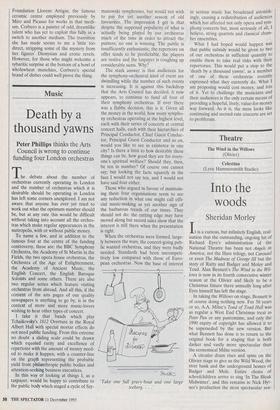Music
Death by a thousand yawns
Peter Phillips thinks the Arts Council is wrong to continue funding four London orchestras The debate about the number of orchestras currently operating in London and the number of orchestras which it is desirable should be operating in London has left some corners unexplored. I am not aware that anyone has ever yet tried to work out what the optimum number should be, but at any rate this would be difficult without taking into account all the orches- tras which make regular appearances in the metropolis, with or without public money.
To name a few, and in addition to the famous four at the centre of the funding controversy, these are: the BBC Symphony Orchestra, the Academy of St Martin in the Fields, the two opera house orchestras, the Orchestra of the Age of Enlightenment, the Academy of Ancient Music, the English Concert, the English Baroque Soloists and some others. There are also two regular series which feature visiting orchestras from abroad. And all this, if the content of the arts pages of our quality newspapers is anything to go by, is in the context of more and more music-lovers wishing to hear other types of concert.
I take it that bands which play Tchaikovsky's 1812 Overture in the Royal Albert Hall with special mortar effects do not need public funding. From this extreme no doubt a sliding scale could be drawn which equated rarity and excellence of repertoire with the amount of money need- ed to make it happen, with a counter-line on the graph representing the probable yield from philanthropic public bodies and attention-seeking business executives.
In this way of looking at things I, as a taxpayer, would be happy to contribute to the public body which staged a cycle of Szy-
manowski symphonies, but would not wish to pay for yet another season of old favourites. The impression I get is that despite the supposed popularity of what is actually being played by our orchestras much of the time in order to attract the punters, no one is winning. The public is insufficiently enthusiastic, the repertoire on offer tends to be predictable, the players are restive and the taxpayer is coughing up considerable sums. Why?
The stark answer is that audiences for the symphony-orchestral kind of event are dwindling while the number of such events is increasing. It is against this backdrop that the Arts Council has decided, it now appears, to continue to fund all four of their symphony orchestras. If ever there was a flabby decision, this is it. Given all the money in the world, how many sympho- ny orchestras operating at the highest level, each with their series of concerts at central concert halls, each with their hierarchies of Principal Conductor, Chief Guest Conduc- tor, Principal Guest Conductor and so on, would you like to see in existence in one city? Is there a limit to how desirable these things can be, how good they are for every- one's spiritual welfare? Should they, then, be ten in number? Of course one cannot say; but looking the facts squarely in the face I would not say ten, and I would not have said four either. • Those who argued in favour of maintain- ing these four organisations seem to see any reduction in what one might call offi- cial music-making as yet another sign of the barbarous trends of our times. They should not do: the cutting edge may have moved along but record sales show that the interest is still there when the presentation is right.
When the orchestras were formed, large- ly between the wars, the concert-going pub- lic wanted orchestras, and they were badly needed. Standards had been uncompeti- tively low compared with those of Euro- pean orchestras. Now the base of interest 'Take one full gravy-boat and one large iceberg. . . in serious music has broadened astonish- ingly, causing a redistribution of audiences which has affected not only opera and sym- phony concerts but, most seriously of all, I believe, string quartets and classical cham- ber ensembles.
What I had hoped would happen was that public subsidy would be given to two of our orchestras in sufficient quantity to enable them to take real risks with their repertories. This would put a stop to the `death by a thousand yawns', as a member of one of these orchestras recently expressed what they currently do. What I am proposing would cost money, and lots of it. Yet to challenge the musicians and their audiences is the only certain means of providing a hopeful, lively, value-for-money way forward. As it is, the mess looks like continuing and second-rate concerts are set to proliferate.


































































 Previous page
Previous page